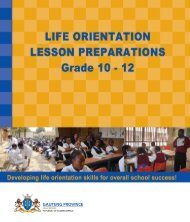Life Science Grade 11
Life Science Grade 11
Life Science Grade 11
Create successful ePaper yourself
Turn your PDF publications into a flip-book with our unique Google optimized e-Paper software.
<strong>Grade</strong> <strong>11</strong> <strong>Life</strong> <strong>Science</strong>s Lesson PlansGRADE <strong>11</strong> SUBJECT <strong>Life</strong> <strong>Science</strong>s WEEK Week 1 TOPIC Bacteria - Structure LESSON 3LESSON SUMMARY FOR: DATE STARTED:LESSON OBJECTIVESDATE COMPLETED:Content:Basic structure and general characteristics.• Use charts, electron-micrographs, microscopes etc, to describe the general structure of bacteria.• Study the basic shapes and arrangements of bacteria.• List the general characteristics of bacteria.The learners will be able to:• Describe the general structure of bacteria.• Identify and or explain the basic shape and arrangement of bacteria.• List the general characteristics of bacteria.TEACHER ACTIVITIES LEARNER ACTIVITIES TIMING RESOURCES NEEDED1. Discussion, annotated diagrams, table.1.1 Introduction• Ask learners to explain what they understand by ‘bacteria’.• How big/small are they?• What do bacteria look like?• Write all of the learner answers on the chalkboard.• Question and answer.5 minChalkboard, OHT1.2 Main Body (Lesson presentation)• Explain to the learners the difference between the terms ‘prokaryote’ and ‘eukaryote’; as wellas between unicellular and multicellular.• Prokaryote: an organism with no true nucleus (i.e. it is not bound by a membrane).• Eukaryote: an organism with a true nucleus (i.e. .a nucleus bound by a membrane).• Unicellular: a single celled organism• Multicellular: an organism made up of many cells.• Learners to write down thedefinitions: prokaryote,eukaryote, unicellular andmulticellular in their note books.20 min• Solutions for all <strong>Life</strong><strong>Science</strong>s <strong>Grade</strong><strong>11</strong> pp.7 - 9• Oxford Successful<strong>Life</strong> <strong>Science</strong>s<strong>Grade</strong> <strong>11</strong> pp. 14Learners should write the following information in their workbooks.• Bacteria do not have a true nucleus or membrane- bound organelles• Their genetic material is a single strand of DNA that is coiled to form a nucleoid• Each bacterium is a single cell but may join together to form colonies• They have a cell membrane that is surrounded by a cell wall• The cell wall is made of polysaccharides that are bonded to short chains of amino acids unlikeplant cell walls that are made of cellulose• Most bacterial cell walls are surrounded by a slime capsule to protect them from harmfulsubstancesTerm 1 Page 6© Gauteng Department of Education (CAPS version)







